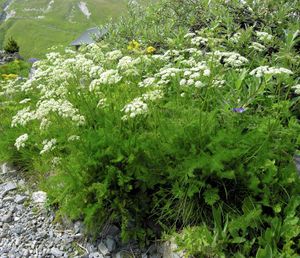Spignel
From Wikiwel
Other Names : Meum athamanticum, Spignel, baldmoney, wood spignel, baldmoney, bear fennel, Alpine Lovage, spicknel, spikenel, mew, meu, bearwort, fenouil des Alpes, mountain fennel, meo, bjørnerod, Bärwurz, snauskjoldblom, sköldpaddsört, Bergwortel, bergvenkel
Special Precautions of Spignel
Health Benefits and Uses of Spignel
In folk medicine, Spignel root is a medicine for menstrual problems and urinary tract disorders. It's a diuretic, which means it's moisturizing. Active components in the essential ols are beta-ocimene, gamma-terpinene, terpinolene en p-cymene
- The root has been used as a tea to relieve indigestion, improve appetite and balance irregular menstrual cycles.
- Meum has been cultivated in Scotland, where the roots were eaten as a root vegetable. The delicate, feathery foliage has been used as a condiment and in the preparation of a wide variety of home remedies as a diuretic, to control menstruation and uterine complaints and to treat catarrh, hysteria and stomach ailments.
- it is used in catthar, hysteria and stomach diseases, at least according to English herbal medicine.
- In the Middle Ages in Germany it was seen as a plant that is good for the bladder, urinary tract, liver and kidneys. It was used for fluidity or edema, jaundice, painful intestines and bladder stones.
- In the Black Forest in Germany, the cows eat a lot of mountain fennel which makes the cheese of this milk an additional tasty taste.
- In Germany there is a medicinal herb honey called Bärwurzbirnenhonig. Literally, this means mountain fennel honey. It is made of bees honey to which herbs such as mountain fennel have been added, mixed with a puree of pears.
- In addition, mountain fox has a healing effect in gastric ulcer, digestive problems and menstrual periods. Hildegard van Bingen wrote that mountain fox was good for gout but she seems to be the only in this prescription.
- The root of spignel is similar, both in flavor and its effects, to the roots of angelica and lovage, and can be used in similar ways as these two plants to treat excessive intestinal gas (flatulence) and other uncomplicated digestive problems.
- Both the root and leaves of spignel have a reputation as a good treatment for snake bites and coughs, and in the past, it was believed that an alcohol extract of the herb had aphrodisiac properties.
- The root is used for the distillate called “Bärwurz”, but most distilleries use the more highly cultivated masterwort. The stoneware bottles it comes in are as integral a part of a Bavarian forest dinner as bread and bacon.
- Bärwurz seeds also proved to be an export hit for the Black Forest region in centuries past. “Bärwurzsalz”, or baldmoney salt, was created by taking the leaves harvested in the springtime, drying them and mixing them with sea salt.
